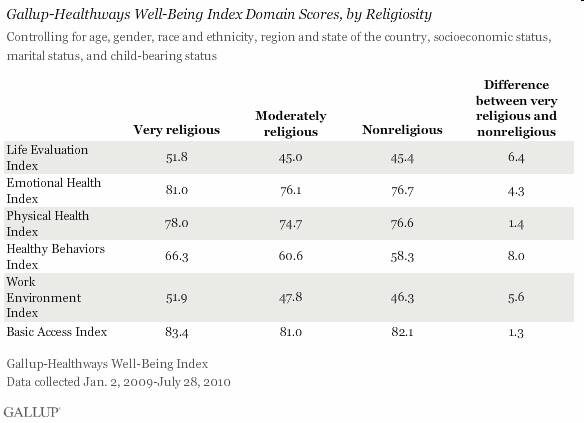This post will begin a multi part series on the fact that “Very religious” people are more mentally, emotionally and physically healthy than “Nonreligious.” Keep in mind that while all atheists are “nonreligious,” not all “nonreligious” are atheists.
Also, keep in mind that some atheists engage in religious practices such as Sam Harris: the mystic atheist Buddhist who does not like the terms mystic atheist or Buddhist (see here). And keep in mind that for some, if not all, atheists, atheism is a “religion.”
For a previous report see: Are Atheists Healthy, Happy, Moral, etc.?
The following is from Frank Newport, Sangeeta Agrawal, and Dan Witters, “Religious Americans Enjoy Higher Wellbeing – Relationship holds when controlling for key demographics,” Gallup, October 28, 2010
…Americans who are the most religious also have the highest levels of wellbeing. The statistically significant relationship between religiousness and wellbeing holds up after controlling for numerous demographic variables. Higher levels of healthy behaviors, life evaluation, work environment perceptions, and emotional health affect religious Americans’ high wellbeing.
“Well-Being Index score” for the “Very religious” was 68.7 whilst for both “Moderately religious” and “Nonreligious” it was the same, at 64.2.1
The difference in wellbeing between the religious and nonreligious populations is highly statistically significant given the large sample size this research uses, and would occur by chance alone on an infrequent basis. The difference is also notable given that Well-Being Index scores do not vary widely across sub-groups of the U.S. population…Very religious Americans enjoy at least modestly higher scores across all six of the key wellbeing areas compared with moderately and nonreligious Americans.
The six are as follows:

The most substantial differences between the very religious and nonreligious groups are in the Healthy Behaviors, Life Evaluation, Work Environment, and Emotional Health indexes. Differences between the very religious and nonreligious on the Physical Health and Basic Access indexes are smaller, but statistically significant. In both of these cases, the larger gap exists between the very religious and moderately religious groups, rather than between the very religious and nonreligious groups…
Americans who are very religious have higher wellbeing than those who are less religious, a relationship that holds even after controlling for several related demographic and geographic variables…
